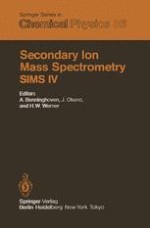1984 | OriginalPaper | Chapter
The Role of Standards in Secondary Ion Mass Spectrometry
Authors : D. E. Newbury, D. Simons
Published in: Secondary Ion Mass Spectrometry SIMS IV
Publisher: Springer Berlin Heidelberg
Included in: Professional Book Archive
Activate our intelligent search to find suitable subject content or patents.
Select sections of text to find matching patents with Artificial Intelligence. powered by
Select sections of text to find additional relevant content using AI-assisted search. powered by
In the evolution of a basis for quantitative compositional analysis in an instrumental technique, the development of standards plays a critical role. For techniques which utilize a primary beam of radiation to excite secondary radiation which is characteristic of the sample composition, the measured signal intensity i for a constituent x is a complex function of C, the atomic concentration, specimen parameters (that is, matrix effects M), and instrument parameters I: (1) $${\rm{i = f}}\left( {{\rm{C,M,I}}} \right).$$ If the interactions of the primary and secondary radiation with the sample and the secondary radiation with the measuring instrument can be accurately described, then i could be measured and C calculated directly. Unfortunately, it is rare in any of the instrumental analysis techniques to obtain such complete characterization of the matrix and instrumental factors, and this is particularly true for secondary ion mass spectrometry (SIMS). In SIMS the secondary ion signals are strongly affected by the electronic character of the matrix [1], by modifications of the matrix due to implantation of the primary ions [2], by adsorbed atoms on the sample surface [3], and in crystalline samples, by effects of crystal orientation [4]. To complicate further this situation, the collection, transmission, and detection efficiencies of the mass spectrometer are not uniform with mass and may be difficult to measure or calculate accurately.
